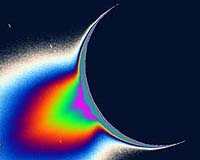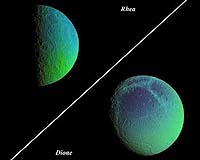
Recent Cassini images of Saturn's moon Enceladus backlit by the sun show the fountain-like sources of the fine spray of material that towers over the south polar region. Image credit: NASA/JPL/Space Science Institute.
Posted on 12/07/2005 1:03:39 PM PST by tricky_k_1972
Cassini Images Reveal Spectacular Evidence Of An Active Moon
 Recent Cassini images of Saturn's moon Enceladus backlit by the sun show the fountain-like sources of the fine spray of material that towers over the south polar region. Image credit: NASA/JPL/Space Science Institute. |
Jets of fine, icy particles streaming from Saturn's moon Enceladus were captured in recent images from NASA's Cassini spacecraft. The images provide unambiguous visual evidence that the moon is geologically active.
"For planetary explorers like us, there is little that can compare to the sighting of activity on another solar system body," said Dr. Carolyn Porco, Cassini imaging team leader at the Space Science Institute in Boulder, Colo.
"This has been a heart-stopper, and surely one of our most thrilling results."
The Cassini images clearly show multiple jets emanating from the moon's south polar region. Based on earlier data, scientists strongly suspected these jets arise from warm fractures in the region. The fractures, informally dubbed "tiger stripes," are viewed essentially broadside in the new images.
The fainter, extended plume stretches at least 186 kilometers (300 miles) above the surface of Enceladus, which is only 186 kilometers wide. Cassini flew through the plume in July, when it passed a few hundred kilometers above the moon.
During that flyby, Cassini's instruments measured the plume's constituent water vapor and icy particles.
Imaging team members analyzed images of Enceladus taken earlier this year at similar viewing angles. It was a rigorous effort to demonstrate that earlier apparitions of the plumes, seen as far back as January, were in fact real and not due to imperfections in the camera.
The recent images were part of a sequence planned to confirm the presence of the plumes and examine them in finer detail. Imaging team member Dr. Andrew Ingersoll from the California Institute of Technology, said, "I think what we're seeing are ice particles in jets of water vapor that emanate from pressurized vents. To form the particles and carry them aloft, the vapor must have a certain density, and that implies surprisingly warm temperatures for a cold body like Enceladus."
Imaging scientists are comparing the new views to earlier Cassini data in hopes of arriving at a more detailed, three-dimensional picture of the plumes and understanding how activity has come about on such a small moon. They are not sure about the precise cause of the moon's unexpected geologic vitality.
 False-color views of Saturn's cratered, icy moons, Rhea and Dione. Image credit: NASA/JPL/Space Science Institute. |
"Only, in the case of Enceladus, the energy source for the geyser-like activity is believed to be due to internal heating by perhaps radioactivity and tides rather than the sunlight which causes cometary jets." The new data also give yet another indication of how Enceladus keeps supplying material to Saturn's gossamer E ring.
Cassini's Photo Album From A Season Of Icy Moons
Pasadena CA (JPL) Dec 07 - Wrapping-up a phenomenally successful year of observing Saturn's icy moons, the Cassini mission is releasing a flood of new views of the moons Enceladus, Dione, Rhea, Hyperion, and Iapetus.
The moons and their intricacies are being highlighted today at a news briefing held today at the American Geophysical Union meeting in San Francisco, Calif.
Several new images of Rhea, a moon measuring 1,528 kilometers (949 miles) across, were taken during Cassini's most recent close flyby on November 26. During the encounter, Cassini dipped to within 500 kilometers (310 miles) of Rhea's surface.
Additional new images include two "zoomable" mosaics of Rhea and Hyperion at high resolution; false-color views revealing compositional variation on the surfaces of Hyperion, Dione and Rhea; two movies reproducing Cassini's exciting encounters with Iapetus and Hyperion; and dazzling new images of the plumes of Enceladus, including a time-lapse movie.

And it's neighboring moon, Boorido.
What are the boundries you consider unique?
I would think the earth's history of mass exticntion events is unique. It would be interesting to have some additional histories of planets with life to help assess the probability of species having language.
I hope this summer's "what have we ever gotten for our investment in NASA" crowd are watching. . .
I disagree. In a dynamic solar system (and I would put money down that is the norm) those kind of events would be typical for a world with a viable ecosystem.
Thanks. :-)
186 kilometers does not equal 300 miles...maybe it was supposed to be 300 kilometers (186 miles).
Good catch! :-)
And to think... until the last century or so, we couldn't see them or even recognize that they existed. Yet they surely existed.
Neither do I. Hard to make a curve with only one data point. :-)
I certainly do not "believe" in ET. I suspect ET is out there due to the huge number of stars and galaxies, however, I most certainly do not "buy" we have been visited. It's possible, just very unlikely.
I mistyped. I meant human like physiology, not behavior, but I think you got the point I intended. First, I don't think evolution is directed toward anything in particular. Intelligence is an obvious advantage, but big brains don't necessarily possess the requisites for language. I could see a world stabilized on something like reptiles or insects or fish.
You don't listen to Coast often enough. There has been an exchange student program between the US Army and the [I forget which star system] for over twenty years. The first dozen soldiers have just got back. They aren't allowed to talk, of course.
Maybe we could drop (in on) the (moon) Shaloopa.
L
Well, we must remember that Europa is in a band of heavy radiation, so humans might never land there. We needed another good moon
It has no effect on my religion, I just need to find a good translator =o)
Since technological progress seems to proceed exponentially once it begins I don't think that's a concern.
The Earth is unique until we discover otherwise. It's unlike anything we've discovered so far.
I will argue that in our galaxy, we could very well be the only planet with a electro magnetic technology. Earth is about as perfect for life as a planet can be. Yet the dinosaurs had hundreds of millions of years to develope technology and failed. This says that understanding tech is not easy. Further dogs and chimps are both pretty smart in a lot of ways, but neither could pass 2nd grade math.
Disclaimer: Opinions posted on Free Republic are those of the individual posters and do not necessarily represent the opinion of Free Republic or its management. All materials posted herein are protected by copyright law and the exemption for fair use of copyrighted works.